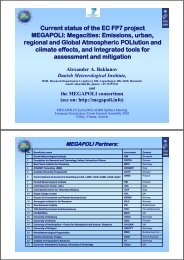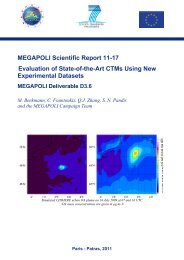D E S C R I P T I O N O F W O R K - MEGAPOLI - Dmi
D E S C R I P T I O N O F W O R K - MEGAPOLI - Dmi
D E S C R I P T I O N O F W O R K - MEGAPOLI - Dmi
Create successful ePaper yourself
Turn your PDF publications into a flip-book with our unique Google optimized e-Paper software.
<strong>MEGAPOLI</strong> 212520<br />
B.1.3.6 Work package description<br />
Table 1.3 c: Work package description<br />
WP1: Emissions<br />
Work package number 1 Start date or starting event: Month 1<br />
Work package title Emissions<br />
Activity Type 1 RTD<br />
Participant number 1 3 4 7 10 14 19<br />
Person-months per participant: 0.5 8 1.5 3 3 13.5 3.5<br />
Objectives<br />
O1.1 Compile regional and global emission inventories for all relevant/desired pollutants and GHGs<br />
O1.2 Deliver (high resolution) state-of-the-art gridded emission maps for present and projection years and nest more<br />
detailed Mega City inventories in the regional or global emission maps<br />
O1.3 Development of a baseline scenario for 2020, 2030 and 2050 for Europe and the relevant megacities e.g., Paris,<br />
London, Rhine-Ruhr, Po Valley, Mexico City<br />
O1.4 Validate and improve EI’s in cooperation with other WPs through comparison of measured-modelled<br />
concentrations, source strength analysis and use of source apportionment results.<br />
Description of work and role of participants<br />
Task 1.1: Global anthropogenic and natural emission inventories (lead: TNO, MPIC, FMI)<br />
The effort in this task concentrates on compiling and combining available global inventories e.g., EDGAR (TNO and<br />
MPI are co-developers), the EU-IP RETRO database (TNO) and the global carbonaceous aerosol inventory (Bond et al<br />
(2004)., enhancing the resolution of the current gridded data and nesting the case study cities accurately in the global<br />
data base. For natural sources, the modellers will start out with what is currently available. In cases where deficiencies<br />
are found, e.g., because certain regional-scale natural sources are found to significantly influence the Mega City AQ, a<br />
further assessment of the natural source strength will be made, e.g., by implementing a new source function for sea salt<br />
or soil dust.<br />
Task 1.2: Regional Pan-European anthropogenic emission inventory (lead: TNO, USTUTT)<br />
This task will provide complete Pan-European emission inventories and high resolution emission maps of primary<br />
anthropogenic particulate matter (PM), Black carbon (BC) and primary Organic carbon (OC) and other desired<br />
pollutants at a resolution of 1/8 x 1/16 lola (or ~ 6 x 6 km) for the base year as inputs to the regional modelling activities<br />
in WP 5 and 6. Relevant emission characteristics important for improving the predictive capacity of the models will be<br />
improved and included where possible. A gridded map of natural PM emissions for Europe will be provided based on<br />
the results of the EU NATAIR project (USTUTT) to complete the data for regional AQ and Climate modelling. A novel<br />
development in the EU-IP EUCAARI is the development of a first particle number emissions database. Since PN may<br />
be important to predict the climate effects of the megacity plume we propose to use the preliminary finding from<br />
EUCAARI to make a PN emission plume for the megacity of focus. If desired by modellers, (limited) effort will be<br />
placed in NOx splitting (NO and NO2) and SOx splitting which is relevant especially in the higher resolving models.<br />
Depending on the megacity of focus an assessment of the importance of shipping emissions for megacity AQ will be<br />
made<br />
Task 1.3: Development of a baseline scenario (lead: USTUTT, TNO)<br />
This task involves the provision of a baseline scenario for the years 2020 and 2030 and a rough estimate for 2050 for<br />
Europe and for the case study Mega Cities (Paris, London, Rhine-Ruhr, Po Valley, Mexico City). The baseline<br />
scenarios are the basis for the analysis of emission reduction measures and strategies in WP 8. Due to budget restriction,<br />
it will only be possible to use already existing scenarios; if for the cities scenarios are not available, they will be<br />
generated by downscaling the emissions for the city area from the European data base. The scenarios will be integrated<br />
and analysed with regard to the major assumptions made.<br />
Task 1.4: Case studies (lead: KCL, CNRS, USTUTT, ARIANET)<br />
Detailed emission inventory data need to be nested in a consistent way in the regional and/or global emission<br />
1 Please indicate one activity per work package:<br />
RTD = Research and technological development (including any activities to prepare for the dissemination and/or<br />
exploitation of project results, and coordination activities); DEM = Demonstration; MGT = Management of the<br />
consortium; OTHER = Other specific activities, if applicable.<br />
33




